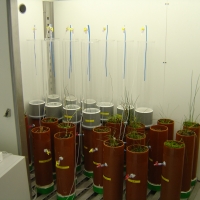By Nathan Currier. 6th November 2011. Dear methane friends – I’m hoping that you might enjoy taking a look at my recent article at the Huffington Post, Methane and the Fierce Urgency of Now, which I hope will be the first of a series focusing on methane in climate policy from a variety of angles. If you like it, please post comments on their site, or just hit the “like” button, as that could help with future pieces becoming “featured” posts, getting linked to their Facebook page, etc. The idea is to help raise public awareness of the significance of methane for near-term climate policy. Further, if any of you have direct comments on it for me, or ideas re future pieces to bring methane issues before the public, I’d enjoy your feedback. Many thanks. Nathan
CO2
Blog: A Business-like Approach to Data Gathering
By Gail Riekie. 31st January 2011.
I expect most MethaneNet users spotted last month’s announcement that private business is to get involved in collecting atmospheric greenhouse gas data.
For those who missed it, the news is that Earth Networks, a US based weather data company, is investing $25 million over the next 5 years to set up a network of 100 sensors which will measure concentrations of CH4 and CO2 around the globe on a long term basis. Earth Networks are working in collaboration with the Scripps Institute, whose scientists will be involved in ensuring that the data acquisition is conducted in line with current research requirements.
My impression is that the research community has reacted positively to the news, welcoming the opportunity for a more comprehensive set of data on spatial and temporal variations in the concentration of these two most important greenhouse gases. Pieter Tans, head of the Carbon Cycle and Greenhouse Gases group at NOAA’s Earth System Research Laboratory, was quoted in the Economist as being ‘cautiously optimistic’ about the new development. Likewise, Euan Nisbet of Royal Holloway, University of London, a prominent expert in the field of methane and global change, told me that “…provisionally I think it is a very good thing…. provided the data are properly calibrated and made open access after a fair commercial-use time”.
It remains the case that this first ‘privatisation’ of greenhouse gas measurements is something of a step into the unknown for the global methane research community. In other areas of endeavour, where commercial operations are involved in gathering or producing information of great interest to academic scientists – genome research and oil exploration are two that come immediately to mind – tensions can arise around issues of access to commercially sensitive data. However, neither of example is a direct analogue for the collaborative GHG gathering venture proposed by Earth Networks and the Scripps Institute.
I am curious to know what other MethaneNet members think of this new development in data gathering. Could the model be extended into other areas of our work? Do you foresee a golden age of plentiful new greenhouse gas data to analyse, or dangers ahead for a research community less in control of the information acquired? Are there other issues that should be considered?
Please do leave a comment and let the network know your views.
Blog: Methane Removal and Climate Change Mitigation?
By Gerd A. Folberth. 19th July 2010.
Air capture of carbon dioxide (CO2) has been proposed as a solution to climate change but the grand challenge is to scale up prototypes to provide cost-effective solutions. Surprisingly air capture of methane (CH4) has not received the same attention as air capture of CO2. In a recently published article (Boucher and Folberth, 2010) we discussed the advantages and disadvantages of artificial methane removal from the atmosphere. Here, we present a summary of the principal arguments.
Methane is the second most important anthropogenic greenhouse gas and its atmospheric abundance has come close to tripling since the beginning of the industrial revolution as a consequence of human activity. Thus, a reduction to pre-industrial levels would alleviate a radiative forcing of 0.48 Wm-2 amounting to roughly one third of the radiative forcing by CO2 (Forster et al., 2007).
Atmospheric methane concentrations are currently about 0.5 percent that of CO2 and the methane atmospheric lifetime (~10 years) is one order of magnitude smaller than the CO2 lifetime (~100 years). However, the methane radiative efficiency is one order of magnitude larger (3.7 10-4 versus 1.548 10-5 Wm-2ppbv-1 – Ramaswamy, V. et al., 2001). The relatively short methane lifetime can be seen as an advantage (fast response to emission reductions or increased sinks) or a disadvantage (response diminishes quickly). The attached figure shows the temperature change expected from removing 1 kg of methane with (black curve) and without (red curve) concurrent capture of CO2 produced by methane oxidation (for details cf. Boucher et al., 2009). Most of the climate benefit is realised within 60 years of methane capture, but a net climate benefit persists for as long as 500 years even without capturing the CO2 stemming from methane oxidation.
From first principle considerations it can be concluded that:
1) the minimum energy required to separate methane from air is given by the opposite of the change in Gibbs free energy when the two gases are mixed. It can be approximated by
Q = (R T / M) (1 + ln (1/x) )
where R is the universal gas constant, T is the temperature, M is the molecular mass of methane and x is its volume mixing ratio (x<<1). Therefore, the minimum thermodynamic energy to separate 1 kg of methane from ambient air is 2.2 MJ or 35.2 kJ/mol; in practice the energy required to separate methane is likely to be much larger.
2) Methane carries significant amounts of chemical energy. The standard enthalpy ΔH0 for methane combustion is -55.6 MJ/kg or -890.4 kJ/mol. In contrast, carbon dioxide, since it is fully oxidized, essentially carries no exploitable energy.
At this most simple level the energy budget would seem to favour air capture of methane quite substantially. However, using a detailed energy balance for CO2 air capture (Zeman, 2007 and references therein) to derive a more realistic assessment of air capturing energy costs for methane shows that “air contacting”, i.e., pumping of air through the removal apparatus, becomes the crucial factor for engineering solutions.
Essentially, due to the lower atmospheric concentration of methane air contacting becomes substantially more expensive energetically. At current concentration methane air capture could require between approximately 300 and 2100 kJ/mol (where we account for the mitigation benefit of removing a much more potent greenhouse gas through normalising the energy costs by the methane 100-year GWP on a molar basis; for details see Boucher and Folberth, 2010) as compared to capturing CO2 which would require between roughly 450 and 675 kJ/mol according to Zeman (2007). The challenge, hence, is to minimise the air contacting costs in the methane removal process.
In essence, the main goal is be to increase the methane sink to balance the increased sources or ultimately surpass them. Secondary benefits are 1) reduced tropospheric ozone production, 2) decreased stratospheric forcing through methane-derived water vapour, 3) a possible further reduction in atmospheric CO2 through CO2 capture and storage in the methane oxidation process and 4) energy recycling by exploiting the methane chemical energy. Potentially, a few hundred kJ/mol of “portable” chemical energy can be recycled by either using methane directly or making accessible the energy via abstracting the hydrogen from the methane molecule or its oxidation products.
The above arguments demonstrate that there are good physical reasons to consider methane air capture in addition to greenhouse gas emission reductions and carbon dioxide air capture as part of a portfolio approach to mitigate climate change. There are however inherent difficulties associated with the very small concentration of methane in the atmosphere and its low chemical reactivity at ambient conditions but it is possible that these can be overcome. However, the substantial challenges of engineering methane air capturing facilities do seem a feasible endeavour in light of all arguments.
References
Boucher, O. et al., Indirect GWP and GTP due to methane oxidation, Environmental Research Letters, 4, 044007, doi: 10.1088/1748-9326/4/4/044007, 2009
Boucher, O. and G.A. Folberth, New Directions: Atmospheric methane removal as a way to mitigate climate change? Atmospheric Environment, 44, pp. 3343–3345, doi:10.1016/j.atmosenv.2010.04.032, 2010
Forster, P. M. de F. et al., Climate Change 2007: The Physical Science Basis, pp. 129-234, Cambridge University Press, 2007
Ramaswamy V. et al., Climate Change 2001: The Scientific Basis, pp. 349-416, Cambridge University Press, 2001
Zeman, Energy and material balance of CO2 capture from air, Environ. Sci. Technol., 41, pp. 7558-7563, 2007
Wetland Methane Link to CO2
24th November 2011.
The striking correlation between atmospheric concentrations of CH4 and CO2, as revealed in ice-core records, has long been a source of speculation as it is not immediately obvious why the two should be so closely linked. A paper by Boardman and co-authors1, published in December’s New Phytologist, has provided new information about the linkage, demonstrating experimentally for the first time that very low concentrations of atmospheric CO2 associated with glacial maxima can lead to lower CH4 emissions from certain wetlands.
Lead author Carl Boardman describes the two-year long experiment investigating the impact of CO2 starvation on wetland CH4 emissions as “an ambitious technical challenge”. The work involved exposing minerotrophic fen and ombrotrophic bog mesocosms to glacial maxima CO2 concentrations (200 ppm) and comparing the associated CH4 emissions to those from mesocosms exposed to ambient CO2 concentrations (400 ppm). In the fen mesocosms, CH4 emissions were suppressed by 29% in the low CO2 atmosphere, with the effect particularly pronounced during warmer summer temperatures. By contrast, the low CO2 had no effect on CH4 emissions from the ombrotrophic bog.
Wetlands are the largest natural source of atmospheric CH4. It is not difficult to think up reasons why CH4 emissions might decrease under low CO2, as was observed in this experiment – for example decreased plant productivity hence less root exudate and so a reduced supply of labile carbon for methanogens, or knock-on effects associated with changes in plant composition. It is far harder to pin down the precise process involved. The reasons why the bog and the fen responded differently to the simulated glacial maxima conditions are also far from clear. What is clear, as noted by Keller2 in a commentary on the Boardman et al paper, is that this study shows how anthropogenic activities leading to changes in amounts of atmospheric CO2, have “already impacted ecosystem processes and will continue to do so in the future”.
Boardman further notes that the results “reaffirm the biological link between atmospheric CO2 and CH4 ice core records” and also “highlight the requirement for better representation of the interaction between low levels of atmospheric CO2 and wetland CH4 emission processes in numerical models aiming to understand the glacial-interglacial variation in CH4 concentration in the atmosphere.”
Boardman CP, Gauci V, Watson JS, Blake S and Beerling DJ. 2011. Contrasting wetland CH4 emission responses to simulated glacial atmospheric CO2 in temperate bogs and fens. New Phytologist 192(4): 898-911.
Keller JK. 2011. Wetland and the global carbon cycles: what might the simulated past tell us about the future? New Phytologist 192(4): 789-792.



